
肉汁餃子のダンダダン 神田店
Nikujiru Gyoza no Dandadan Kanda Ten
3.07
Kanda, Ochanomizu
「Dumplings」
--
2,000-2,999円
Opening hours: Monday, Tuesday, Wednesday, Thursday, Friday
11:45 - 15:00 L.O. 14:30
16:00 - 23:30 L.O. 23:00
Saturday, Sunday, Holidays
11:45 - 23:30 L.O. 23:00
Rest time: Business hours: Special business hours may apply during the year-end and New Year's holidays. Please contact the store directly or check our website for details.
東京都千代田区内神田3-12-2 萬創神田ビル 1F
Photos
(20)

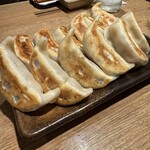













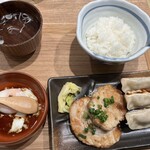




Details
Reservation Info
can be reserved
Payment Method
Credit cards accepted
(VISA, Master, JCB, AMEX, Diners)
Electronic money accepted (transportation system electronic money (Suica, etc.), Rakuten Edy, nanaco, WAON, iD, QUICPay)
QR code payment available
(PayPay, d-payment, Rakuten Pay, au PAY)
Number of Seats
80 seats
Private Dining Rooms
None
Smoking and Non-Smoking
No smoking at the table
Parking
None
Comments
(21)
BQグルメ王
4.00
Compared to famous chains, the price is double, but the amount of meat in these juicy dumplings is more than double! Feeling nostalgic for a rare midday drink, I wandered around Kanda. I remembered craving juicy dumplings and meat-miso bean sprouts, so I decided to visit this spot. For some reason, memories from when I drank in Kinshi-cho resurfaced, and I recalled it was also during a midday drink! So, I ordered the grilled dumplings and meat-miso bean sprouts without looking at the menu, along with a black Hoppy set.
While waiting for the dumplings to cook, I enjoyed my Hoppy with the meat-miso bean sprouts. The bean sprouts were stacked so high on the plate that it was a challenge to eat without spilling! I finished my first Hoppy just as I got through about half of the bean sprouts, so I promptly ordered a second. Although the price for the refill was on the higher end, they serve it in a kettle, which enhances the flavor of the Hoppy from the second drink onward, making it feel reasonably priced!
As usual, I filled my glass to about 80% with Kinmiya (a shochu) without adding ice and topped it up with Hoppy. Just as I was mixing my stronger second drink, the grilled dumplings arrived! I seasoned them with plenty of chili oil and a little soy sauce, taking care to enjoy them while they were piping hot. Delicious as always!
These dumplings are priced over 500 yen for six pieces, which is twice the price of famous chains, but I believe the amount of meat is more than double. The secret ingredient of miso adds to the hearty flavor of these meat-filled dumplings. The filling has a meaty texture, which balances nicely with the not-too-thin, chewy skin. While dumplings with more vegetables and thinner skins can be delicious, my preference is definitely for the "meaty, chewy skin type."
With two strong Hoppy drinks, I enjoyed a perfect afternoon buzz for just about 2000 yen—truly a "grown-up 3 o'clock snack!"



jnglog
3.10
After a bar-hopping night at four places, we ended our evening in Kanda. We rushed to this spot as the popular Aji Sato was already closed for orders. We chose comforting dishes like gyoza, tamago kake gohan (TKG), and simmered noodles, which were perfect for winding down. It was a day that satisfied both our stomachs and our hearts. Thank you for the meal!



けにぃさん
3.30
We visited on a holiday with three people. We made a reservation-free visit around 6:30 PM and were able to get a table, but soon after, more customers arrived and the place quickly filled up. We started by ordering drinks and had the large highball. When ordering, we were recommended to get the dumplings, which take some time to prepare, and some quick-to-make dishes, so we ordered the dumplings and fried burdock. The drinks arrived within five minutes after ordering, and all the food came out in less than ten minutes. The food was delicious, especially the dumplings, and the appetizers like the salad were also very tasty. It was a casual drinking outing, but the quality of the flavors was high, making it quite recommendable!




TA・KA
3.10
On my third stop for a midday drink during a holiday, I headed to my desired restaurant only to find it was on break... I had been caught off guard since their website listed them as open all day. Feeling at a loss, I searched for an open place and ended up here. I had visited another branch for lunch before, but this was my first time coming for drinks. The restaurant was moderately busy, with many customers enjoying drinks alongside their gyoza. A cheerful female staff member welcomed me and seated me at a table near the entrance. I ordered a highball to drink, and of course, I got two plates of gyoza for food. The juicy gyoza had a solid flavor, and they tasted great even without any dipping sauce. For additional food, I ordered taramosalata and salted squid. The taramosalata was surprisingly delicious. I sipped my sour drink while nibbling on the salted squid, and once I felt pleasantly tipsy, I decided to call it a day. The total bill here came to about 4,000 yen per person.


車掌の寝言
3.50
I visited for lunch and the place was fully booked. I had the ultimate gyoza set meal, which included juicy grilled gyoza, domestic onsen egg, specially seasoned tarako, mountain jelly, shiso-flavored vermicelli salad, rice that pairs perfectly with gyoza, and chicken broth wonton soup. The rice was delicious, and there were many side dishes, so I was very satisfied. Of course, the gyoza was exquisite too. Plus, rice refills are unlimited, making it great value for money. The staff's service was also excellent, so I highly recommend this lunch menu.

さわらら
5.00
I used this place for a lunch set. I arrived before it got crowded during the lunch rush and was able to sit right away. Instead of using a mobile device, I placed my order with the staff. My meal arrived shortly after I ordered. I noticed some customers taking takeout, so it seems that many locals use this restaurant too. The gyoza was flavorful enough that it was great even with just vinegar. The chewy skin was also impressive. There were many side dishes like soft-boiled eggs and cod roe that went well with the rice, and I hesitated to ask for a refill, but decided against it this time. It felt a bit like when you take too much at a hotel buffet.

みむまむ
3.40
On the anniversary of the end of the war, I visited to express my gratitude and took a stroll around the Kanda area in Tokyo. It was lunchtime, and I decided to stop by Dandan Kanda as part of my training. I started with a medium draft beer, grilled gyoza, boiled dumplings, and edamame to toast. Enjoying a draft beer during lunch on a hot day truly made me feel grateful to have been born on this planet and in Japan. After that, I enjoyed horse sashimi and horse liver, and everything was delicious. Thank you for the meal. I have been visiting for several years, and it seems that more people are coming to pay their respects at Yasukuni Shrine on this anniversary each year.



ただのご飯を食べる人です
4.00
My wife wanted some merchandise, so we visited the store and ordered from a menu with a bonus item (see photo). They recommended that we try the gyoza without soy sauce first, so we had it as is. The seasoning was rich enough that it didn't need any soy sauce or vinegar at all. I had planned to eat it plain just for the first bite, but I ended up enjoying it that way until the very end. The crispy gyoza skin was delicious, reminiscent of a rice cracker. It felt more like a perfect afternoon snack rather than a meal. Above all, the customer service was polite and left a good impression. I look forward to visiting again, whether there's an event or not.

de9f18
3.70
I came here for the first time, and the cost performance is amazing! The gyoza had a chewy skin and was juicy and very delicious. It was exactly the type of gyoza I love! The beer and highball were also well done. Perhaps it's because the restaurant just opened, but the glasses were chilled and clean, and the highball had the right strength. Moreover, the service from the staff was excellent. They were friendly, and without making it feel too commercial, they came by to ask if I wanted a refill when my glass was empty. And yet... it was cheap!!! I really think this place offers fantastic value for money. I will definitely come back!


ぴーちゃん68
3.00
Since my intended restaurant was closed for the day, I became a solitary lunch refugee and decided to return to a dumpling-centric restaurant for lunch. As soon as I entered the establishment, I was informed that the only lunch option available was a dumpling set meal, but I thought, well, that's fine. The dumplings here are thick-skinned and juicy, delicious enough to eat without any sauce. The meal comes with a soup that also includes boiled dumplings. It’s a dumpling feast!

源ちゃん1980
3.80
This is my third stop! I was wandering around Kanda on a Sunday night, wanting to have a bit more to drink, when I discovered Dandadan and decided to visit. The staff were very friendly and provided excellent service. The gyoza came with plenty of meat, and the skin was thick and hearty! The basashi (raw馬), although inexpensive, could have used a bit more flavor in the meat.



ぴーちゃん68
3.00
When I got to the office, I found myself undecided about lunch since I was alone. I usually aim for a horse meat lunch, but it was closed for the third time in a row. It seems like Mondays are particularly tricky. While wandering around trying to decide where to eat, I stumbled upon a restaurant that seemed easy to enter, specializing in gyoza. Despite the tempting gyoza lunch options, I decided to go for the crispy fried chicken (yurisen). I did add three gyoza to my meal, though. The fried chicken wasn't quite what I expected; it was crispy, and while it wasn't bad, it just didn't match my image of it. On the other hand, the gyoza were delicious, as you would expect from a specialty shop. However, I think a meal that consists solely of gyoza might be a bit much. Also, be mindful that the portion of rice was more than it seemed, so keep an eye on how much you’re eating!

ボク石川
2.00
I often use Dandadan, and I love the gyoza skin chips. However, on this day, due to the crowd, the drinks I ordered took a long time to arrive, which made it difficult to enjoy my time. That said, I probably will use it again.

だるま5656
3.80
I casually got off at Kanda and was drawn into a restaurant by the sign. I started with a beer and some bean sprouts as a small appetizer, slowly enjoying them, and then ordered a set of gyoza! The broth was light and delicious. Since I prefer my gyoza a bit crispier, I decided to add another order to satisfy my craving for crunch! The chicken wing gyoza was definitely the top choice for crispy. It was filled generously and tasty. Wanting a bit more to eat, I asked for a recommendation and was told about the boiled dumplings, so I decided to give them a try after a long time. The plump skin was so delicious! I felt fulfilled both in my stomach and my heart by experiencing Japanese culture and seeing the young staff working happily together with pleasant service. Thank you for the meal!
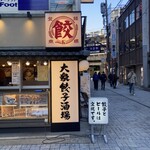



トントンマン
3.50
Recently, an online news report highlighted the annual ranking of prefectures by household gyoza purchasing amounts, which often draws attention. According to the Ministry of Internal Affairs and Communications' Family Income and Expenditure Survey published on February 6, 2024, Hamamatsu City surpassed its rivals, Miyazaki City and Utsunomiya City, to become Japan's top in annual gyoza purchasing for the first time in three years, with a total amount of 4,041 yen. On the morning of February 6, city officials gathered at Hamamatsu City Hall to watch for the survey results, and upon discovering they took the top spot, some staff celebrated with a fist pump. Miyazaki City came in second with 3,497 yen, followed by Utsunomiya City with 3,208 yen. Looking back at the last four years of results, we see a fierce competition:
- 2022: 1st: Miyazaki City 4,053 yen, 2nd: Utsunomiya City 3,764 yen, 3rd: Hamamatsu City 3,435 yen
- 2021: 1st: Miyazaki City 4,184 yen, 2nd: Hamamatsu City 3,728 yen, 3rd: Utsunomiya City 3,129 yen
- 2020: 1st: Hamamatsu City 3,766 yen, 2nd: Utsunomiya City 3,693 yen, 3rd: Miyazaki City 3,670 yen
- 2019: 1st: Utsunomiya City 4,359 yen, 2nd: Hamamatsu City 3,506 yen, 3rd: Kyoto City 2,790 yen
This survey includes fresh and cooked gyoza purchased at supermarkets and takeout specialty shops, but does not account for frozen products or meals from restaurants. The attention brought to such rankings reflects the fact that gyoza has become a beloved national dish.
Inspired by the gyoza discussions, I visited a restaurant located in the Kanda Station West Exit shopping district during lunchtime. The restaurant, "Nikujū Gyoza Seisakujo Dandadan Sakaba," is operated by Dandadan Co., Ltd., part of the NATTY SWANKY Holdings Group. The founders, Yuji Iishi and Tatsuya Tanaka, started their food business in 2001 with a ramen specialty restaurant and a dining bar. A major turning point for the business came in 2011 when they opened their first gyoza-focused izakaya, which gained popularity quickly despite the challenges posed by the Great East Japan Earthquake shortly afterward. The brand has grown to 138 locations, including 81 in Tokyo and others across the Kanto region and beyond.
The specific location I visited is very close to Kanda Station, set in a competitive area featuring several other gyoza spots. The restaurant opened in December 2021 and is now in its third year of operation. I arrived around 11:45 AM, slightly early for lunch, and found myself to be the first customer. The layout includes only table seating, with an unclear number of seats as the official count seems to be inaccurate. Employees exuded great energy while taking orders — their enthusiastic service was almost reminiscent of a cult!
The table menus featured a selection of five lunch set meals, and I chose the "Grilled Gyoza Chashu Lunch" for 900 yen. The regular price for a similar set was 1,065 yen, highlighting the breakfast offerings’ value. After about a 10-minute wait, my meal arrived.
The set included three grilled gyoza and two slices of grilled chashu resting upon shredded cabbage, along with pickled vegetables, a soft-boiled egg, soup, and rice. The gyoza lived up to its name with plenty of flavorful minced pork, although I personally prefer a crispier, golden-brown finish achieved through more oil during cooking, which is a matter of taste. The grilled chashu stole the spotlight with its beautifully crispy outer layer and satisfying heft.
While the soft-boiled egg and soup weren’t standout features, they contributed positively to the meal. Overall, given the lunch price, I felt satisfied with the cost-performance ratio. Although the cooking technique for the gyoza and some aspects of the service could see improvement, I believe these can be addressed. I hope this gyoza restaurant can continue to thrive, playing an essential role in promoting our national dish.



たかみつおじい
3.00
The journey with the Seishun 18 Ticket is nearing its end. Tomorrow, it's back to work. Before tackling the long commute from Tokyo, I decided to go to a dumpling shop where I often ate lunch. Even though it's a dumpling restaurant, they strangely promote horse sashimi. I ordered a dumpling set meal and horse sashimi to fill me up. Of course, I got a large serving of rice. The dumplings were quite tasty.


lcymimi
4.00
I enjoyed the Juicy Meat Dumpling Set Meal (including tax, 748 yen). It features six original juicy dumplings, a soft-boiled egg, pickled vegetables, miso soup, and rice. The restaurant is clean, and the table seating is well organized. When it comes to service, Danda Dan is known for its attentive and enthusiastic staff, making for a pleasant lunch experience. They also offer an app, so you can check in during your visit to earn points and receive discount coupons.


らーめんの人
3.30
I had an early lunch in Kanda at 11:40 AM. I went to Kanda Wise, which I had wanted to try, but there was a long line... In winter, I'd wait, but it was too hot today—next time, I'll go right when it opens. Then I saw that Taneseya has also expanded, and there was a line there too... So, I decided to skip the line since I dislike waiting and went to the place across the street, Dandan Dantan, which is known for its juicy dumplings. I ordered the dumpling set for 750 yen, with an extra large portion of rice for an additional 50 yen. The staff told me that the dumplings are tasty enough to eat without any dipping sauce! Honestly, I thought, "No way," but when I bit into the dumpling, I was blown away—it was incredible! It felt like a combination of a gyoza skin from the White Gyoza in Noda stuffed with soup dumplings! This is seriously delicious! The quality of this lunch at a chain restaurant is impressive. Thank you for a great lunch!
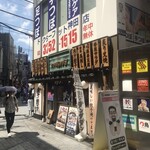
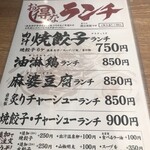

佐藤修平
3.70
Dandadan is a reliable choice found at various stations. I often visit for dinner or just to enjoy a set meal. This location has many table seats and is close to the station, making it convenient for groups to go out for drinks. Personally, I find it easy to use for after-work drinks with colleagues, and I really like it.

無芸小食
3.10
Right after entering the Kanda Station West Exit shopping street, Dandan, known for its juicy gyoza, opened in December 2021 at the location that used to be Chao Wang, which served meat sauce fried rice. Dandan is currently doing exceptionally well, with 117 locations across Japan from Hokkaido to Kyushu. I remember visiting their first shop in Chofu over ten years ago; I never imagined they would grow this big. The operating company, Natty Swanky, received the "Shining Management Award" at the 2018 White Company Awards, indicating high employee satisfaction. I have the Dandan app installed; by collecting stamps at the locations, you can earn titles like Gyoza Soldier (1), High-Quality Gyoza Soldier (3), Gyoza Leader (4), Hundred Gyoza Leader (7), and so on, culminating in Gyoza General (28). The app offers perks by allowing users to accumulate 10 points each day just for logging in, with 500 points equating to a 500 yen meal voucher. I’ve already scored 500 points. (^^ゞ
On April 2022, it was just past 11 PM when my companion suggested, "Let’s go to one more place!" So, we popped into this lively spot near the station despite the late hour, buzzing with young people. We started off with a draft beer (528 yen) and toasted with the slim glass of Premium Malt's, which promises to serve "the best of the best frothy beer." However, the cost-performance ratio for the beer didn’t seem great. We also ordered the Meat Juice Grilled Gyoza (506 yen) and Boiled Gyoza (528 yen) for snacks. The Meat Juice Grilled Gyoza is a signature item, and its deliciousness is assured. It’s pre-seasoned, so you can enjoy it as is. Yet, again, the cost-performance didn’t seem favorable.
I also tried something called Electric Doctor (506 yen), which is a mix of Electric Bran and Dr. Pepper. Electric Bran, known from Asakusa's "Kamiya Bar," is a brandy-based alcohol that supposedly gives you a tingling sensation! Dr. Pepper, on the other hand, is known as a cult favorite "intellectual beverage." The combination of these two created an unexpectedly refreshing drink. I enjoyed the Electric Doctor alongside the gyoza. It was remarkable how the place remained lively late into the night, filled with young patrons. Those who can’t see the value in this and only care about cost-performance are likely just out of touch with the times.
On July 2023, it was again past 11 PM when I stopped by for what would be my last drink of the night. I was informed that the last order for food had already passed, so I could only order drinks. I clinked glasses with a Premium Malt's (658 yen) and a large highball (647 yen)! Once again, the prices felt high. I opted for a refill of shochu highball (438 yen) and used a 1,000 yen coupon I had saved in the app.



神田のサラメシ
3.00
No. 436 "Dandadan Gyoza" Kanda Branch, May 2, 2023. Arrival time: 12:10 PM. Waiting time: None. Serving time: 11 minutes. Post-pay system. The restaurant has around 80 seats centered around tables.
I ordered the grilled gyoza and char siu lunch for 900 yen. Even though it was during the Golden Week, everyone was on holiday, so I planned not to meet anyone from work and thought I might as well eat as much garlic as I wanted. Stepping into Dandadan Gyoza, I recalled I might have visited once during my student days.
The moment I took a bite, the meat juice burst out. It was really delicious! I felt like having a highball to wash it down. The char siu was crispy rather than juicy. However, I felt that for the volume, 900 yen wasn’t entirely satisfying. I wished I had at least one full serving of gyoza. I almost considered going for a second lunch afterward. But then again, I usually overeat, so this might just be the standard single serving.
Thank you for today’s meal!
#DandadanGyoza #GyozaLunch #Gyoza #CharSiu #IzakayaLunch #KandaLunch #KandaGourmet #JimbochoLunch #NihonbashiLunch #AwajichoLunch #OgawamachiLunch #OtemachiLunch #TokyoLunch #KandaSalaryman



Email Login